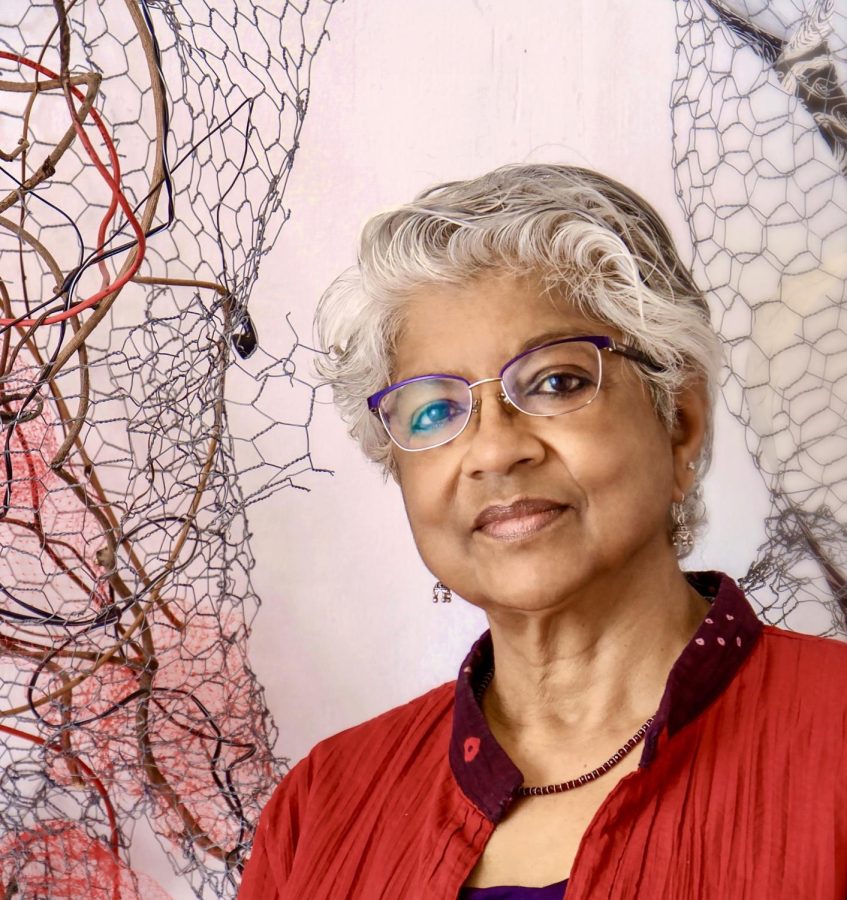Evanston-based sculpturist Indira Freitas Johnson centers community in her art, draws on Indian influences
Photo courtesy of Indira Freitas Johnson
Indira Freitas Johnson. The Evanston artist is featured in an exhibit at the Evanston Art Center.
October 25, 2021
For Evanston-based sculpture artist Indira Freitas Johnson, art and nonviolence have always been intertwined.
Growing up in Mumbai, she was influenced by her parents’ work. Her mother started a community development center and her father, a follower of Mahatma Gandhi, was an artist.
“(My father) would tell us stories about Gandhi’s nonviolent methods,” Johnson said. “That was a gift to me, and I wanted to pass it to others.”
Johnson’s first experiences with art were participating in her father’s community projects, but her formal education was in advertising. She attended the Sir J.J. School of Applied Art in Mumbai, and then earned a Master of Fine Arts in advertising design from the School of the Art Institute of Chicago. Eventually, she transitioned from the advertising industry to experimenting with sculpture making.
Since then, Johnson’s sculptures have been featured in the Chicago Museum of Contemporary Art, the Rhode Island School of Design Museum and the Mobile Museum of Art. She was also named a “Chicagoan of the Year” by Chicago Magazine in 2013 for her “Ten Thousand Ripples” sculpture project.
One of her biggest art influences came when she worked with Madhubani painters early in her career, Johnson said. Madhubani is a painting style practiced mainly by women in the northern Indian state of Bihar, characterized by its geometric patterns.
“That idea of folk art traditions is something that I am very interested in — how you can take some of those traditions which were meant to be family traditions… and make that into a community tradition,” Johnson said.
Johnson often engages in community art and collaboration, according to Paula Danoff, president and CEO of the Evanston Art Center.
Danoff referenced a project Johnson completed with Evanston residents last year as an example of the artist’s passion to intertwine community and art.
“She did a whole thing about decorating, painting and doing other designs on hosta leaves, and then they released them in the canal,” she said.
Danoff said Johnson’s collaboration with Chicago communities through her “Ten Thousand Ripples” project was an example of community engagement. Through the project, which began in 2012, Johnson worked with communities in Chicago to place sculptures of Buddha in 10 neighborhoods. The purpose of “Ten Thousand Ripples” was to motivate people to think about peace and nonviolence, Johnson said.
Cara Feeney, director of exhibitions at the Evanston Art Center, lived close by to some of the sculptures in “Ten Thousand Ripples,” which is how she came to know Johnson’s art.
Feeney and Danoff have been working with Johnson to bring her new exhibition, “The Resonance of Emptiness,” to the Evanston Art Center. The exhibition primarily contains sculptures made of found objects, exploring the concepts of emptiness and peace. They both shared that a notable piece from the exhibit was “The Empty Bowl,” which is an art piece that invites audience participation.
“Visitors of the gallery are asked to think about something that is weighing them down and pick a piece from a bowl and put it in a circle outside of the bowl,” Feeney said. “I’m able to see this circle around the bowl grow. It’s a physical representation of the community participating in her work.”
The exhibition is on display at the Evanston Art Center through Nov. 14.
Johnson hopes the exhibition’s focus on transforming everyday objects, such as stoves and seeds, will ultimately connect with the audience.
“(It’s) the idea that they can place themselves in this flow of transformation, and be able to contemplate and think about the interconnectedness and the impermanence that is part of everyday life,” she said.
Email: [email protected]
Related Stories:
— Evanston artist Stephan Collins brings tradition to Chicago silversmithing studio
— Evanston artist David Niari communicates resiliency through his work
— Historian Rebecca Zorach to present “Abolition Art” Sunday at Evanston Art Center


